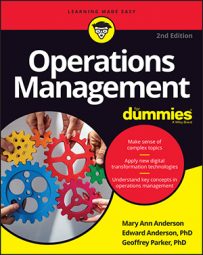Point forecasts, or single-number predictions of demand, are generally always incorrect. You want an accurate forecast to inform your operations management. That’s why you need not only an expected value (what you think demand will be) but also a measure of your method’s forecasting error.
Here are the fundamental tenets of forecasting:
Aggregated forecasts are more accurate than disaggregated forecasts. Forecasting the demand for a product at a national level is more accurate than forecasting it at each individual retail outlet. The variation of demand at each sales point is smoothed when aggregated with other locations, providing a more accurate prediction. You can achieve a similar improvement by forecasting the aggregate demand for all the variations of a product combined.
Be prepared to change your forecasting model, but don’t overreact to random changes. Demand patterns can and do change, and when actual changes occur, you may need to change your forecasting technique. Measuring your forecasting error can alert you when changes occur; however, you need to verify that a sustainable change has actually occurred and that what you observed isn’t a random variation.
Don’t substitute forecasts for known information. Many companies can become blinded by their forecast and ignore what’s actually occurring in the business environment. If something changes, such as a weather occurrence, or more data becomes available, such as a sales order, be prepared to adjust your forecast to incorporate the new information.
If a simple technique yields acceptable accuracy, don’t use a more advanced technique. Use the simplest forecasting model that provides the desired accuracy. For example, don’t use a model for seasonality unless it gives you noticeably greater accuracy than a simple exponential smoothing model.
Select a forecasting technique that makes good use of the available data. The time-series forecasting methods rely on having not only a large quantity of data but also relevant and accurate data. If you don’t have confidence in the amount or quality of the data, you may want to choose a qualitative method to forecast until data becomes available.
For example, consider basing your forecasts on potential market size and adjusting based on experience. Applying sophisticated forecasting models to faulty data won’t improve the underlying quality of the data or the forecast.
Short-term forecasts are more reliable than long-term forecasts. The forecast horizon, or how long into the future the forecast predicts, has a direct impact on accuracy. In other words, predicting the sales for this month is easier than predicting the sales for a year from now.
Many things can happen between now and next year, such as new competitors entering the market, customer preferences changing, or new technology causing shifts in demand. These changes become tougher to predict as the forecast horizon increases.
There is no single best forecasting technique. The important point is to compare different forecasting models and choose the one that best meets the needs of your situation and matches the data you have available.
It’s important to note that, although disaggregate forecasts can be less accurate than aggregate forecasts, disaggregate forecasts are critical to production planning. For example, if a firm produces different models of TVs, production planning at the manufacturing floor level requires a detailed number of how many of each model to produce.
By postponing a commitment to the details, the firm can make a more accurate disaggregate forecast (short-term forecasts are more accurate than long-term forecasts). Reducing flow times allows a firm to delay the decision on what exact models to produce, which improves its forecasts.

